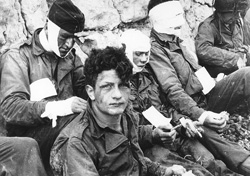Overview
Roots in Civil War Combat Care

Civil War - Union Army Maj. (Dr.) Jonathan Letterman organized the first consolidated divisional tent field hospital and a tiered ambulance evacuation system. For his innovations, Letterman became known as the father of modern U.S. military operational medicine. Source: National Library of Medicine
Prior to the Civil War, medical care in the military was provided largely as a function of the regimental surgeon and surgeons mates. While further attempts were made to establish a centralized medical system, care provision was largely local and limited. The availability of effective treatment for disease and injury was, by modern standards, primitive. Significant changes began to occur near the time of the Civil War, when improvements in medical science, communications and transportation made centralized casualty collection and treatment more practical.
During World War I, the U.S. Army Medical Department expanded and developed greater organization and structure. Care began on the battlefield and was then transferred to successively greater levels of medical capability. Considerable medical service capability was located in the combat theater. This capability was to ensure the availability of needed care, and to help maintain combat unit strength by returning soldiers to duty if their condition could be effectively treated in theater. Expansion continued during World War II to meet changing needs of the war.
After World War II, the Executive Branch of the U.S. Government underwent significant reorganization. The separate Department of War and Department of the Navy were re-aligned under a single Department of Defense. The reorganization created conflict as the Army had evolved its own medical system, as had the Navy. Furthermore, the Air Force, originally part of the Army, was created as a separate military service with its own separate medical service.
Health Care System Evolved After World War II

Normandy Invasion, June 1944 Wounded men of the 3rd Battalion, 16th Infantry Regiment, 1st Infantry Division, receive cigarettes and food after they had stormed "Omaha" beach on "D-Day", 6 June 1944., Army Signal Corps Collection in the U.S. National Archives. SC 189910
Changes in the perception of health care in the post World War II era and an assessment of medical services provided to dependents caused Congress to re-evaluate the dependent health care benefit in the late 1950s. At that point changes in tax law had induced business and industry to begin offering a health care benefit as an employment incentive. A 1956 Department of Defense estimate was that 40 percent of active duty dependents did not have access to federal facilities due to distance, incomplete medical coverage at the federal facility, or due to the saturation of services at military treatment facilities. Congress responded by passing the Dependents Medical Care Act of 1956 and the Military Medical Benefits Amendments of 1966. These acts created the program know as the Civilian Health and Medical Program of the Uniformed Services (CHAMPUS).
In the late 1980s, because of escalating costs, claims paperwork demands and general beneficiary dissatisfaction, DOD initiated a series of demonstration projects. Under a program known as the CHAMPUS Reform Initiative (CRI), a contractor provided both health care and administrative-related services, including claims processing. The CRI project was one of the first to introduce managed care features to the CHAMPUS program. Beneficiaries under CRI were offered three choices - a health maintenance organization-like option called CHAMPUS Prime that required enrollment and offered enhanced benefits and low-cost shares, a preferred provider organization-like option called CHAMPUS Extra that required use of network providers in exchange for lower cost shares, and the standard CHAMPUS option that continued the freedom of choice in selecting providers and higher cost shares and deductibles.
Although DOD's initial intent under CRI was to award three competitively bid contracts covering six states, only one bid, made by Foundation Health Corporation (now Health Net) covering California and Hawaii, was received. Foundation delivered services under this contract between August 1988 and January 1994.
In late 1993, in response to requirements in the DOD Appropriation Act for Fiscal Year 1994, the DOD announced plans for implementing a nationwide managed care program for the MHS that would be completely implemented by May 1997. Under this program, known as TRICARE, the United States would be divided into 12 health care regions. An administrative organization, the lead agent, was designated for each region and coordinated the health care needs of all military treatment facilities in the region. Under TRICARE, seven managed care support contracts were awarded covering DOD's 12 health care regions.
Since then, TRICARE has undergone several restructuring initiatives, including re-alignment of contract regions, Base Realignment and Closure, and the addition of "TRICARE for Life" benefits in 2001 for those who are Medicare-eligible, and "TRICARE Reserve Select" in 2005.